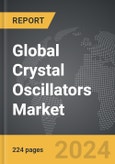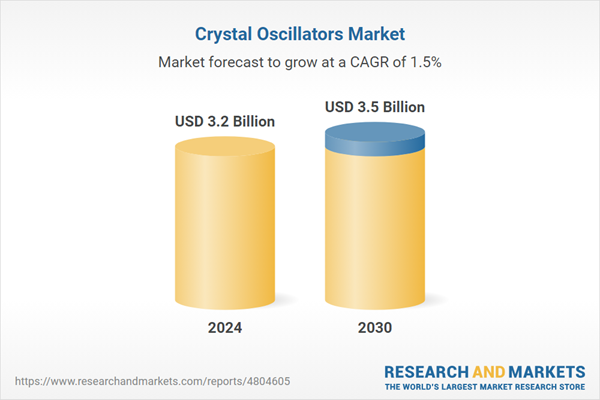The global market for Crystal Oscillators was valued at US$3.2 Billion in 2024 and is projected to reach US$3.5 Billion by 2030, growing at a CAGR of 1.5% from 2024 to 2030. This comprehensive report provides an in-depth analysis of market trends, drivers, and forecasts, helping you make informed business decisions. The report includes the most recent global tariff developments and how they impact the Crystal Oscillators market.
Segments: Mounting Scheme (Surface Mounted, Thru-Hole); End-Use (Consumer Electronics, Telecom & Networking, Military & Aerospace, Industrial, Research & Measurement, Other End-Uses).
Geographic Regions/Countries: World; United States; Canada; Japan; China; Europe (France; Germany; Italy; United Kingdom; and Rest of Europe); Asia-Pacific; Rest of World.
The analysts continuously track trade developments worldwide, drawing insights from leading global economists and over 200 industry and policy institutions, including think tanks, trade organizations, and national economic advisory bodies. This intelligence is integrated into forecasting models to provide timely, data-driven analysis of emerging risks and opportunities.
Global Crystal Oscillators Market - Key Trends and Drivers Summarized
How Do Crystal Oscillators Keep the World in Sync?
Crystal oscillators are pivotal components in modern electronic devices, functioning as the primary timekeeping source and ensuring the precise frequency control required for processing digital signals. At the heart of a crystal oscillator is a tiny piece of quartz crystal, which, when subjected to an electrical charge, vibrates at a consistent frequency. This characteristic makes them incredibly reliable for maintaining clock accuracy in consumer electronics, telecommunications, and computing. The frequency at which the crystal vibrates is highly stable, resisting changes due to temperature fluctuations and other environmental factors, which is why crystal oscillators are indispensable in applications where precision is paramount, such as in GPS units, smartphones, and radios.What Varieties of Crystal Oscillators Exist and Where Are They Used?
Crystal oscillators come in various types, each tailored for specific stability, range, and environmental requirements. The most common types include the AT cut, BT cut, and SC cut crystals, which differ in their angle of cut relative to the crystal axis, affecting their performance characteristics such as frequency stability and reactance. Temperature Compensated Crystal Oscillators (TCXOs) adjust the frequency according to temperature changes, making them suitable for outdoor telecommunications equipment. On the other hand, Voltage Controlled Crystal Oscillators (VCXOs) allow frequency variation through voltage changes, essential in applications like phase-locked loops in radio transmitters and receivers. For the highest stability requirements, Oven-Controlled Crystal Oscillators (OCXOs) maintain the crystal at a constant temperature, providing superior frequency precision for critical military and aerospace applications.What Technological Advancements Are Influencing Crystal Oscillator Development?
The development of crystal oscillators is heavily influenced by advancements in microelectronic fabrication and materials science. Miniaturization is a significant trend, driven by the demand for smaller, more energy-efficient devices with integrated functionality. Modern manufacturing techniques have enabled the production of smaller crystal units that fit into compact electronic devices without compromising their performance. Additionally, research into new piezoelectric materials beyond quartz, such as langasite or gallium orthophosphate, offers potential for higher frequency stability and lower temperature coefficients. These technological improvements not only enhance the performance of crystal oscillators but also expand their application range in the burgeoning fields of IoT (Internet of Things) and wearable technology.What's Driving the Surge in Demand for Crystal Oscillator Technology?
The growth in the crystal oscillator market is driven by several factors, including the proliferation of consumer electronics, advancements in automotive technology, and the expanding telecommunications infrastructure. As electronic devices become ubiquitous and feature-rich, the need for reliable frequency management components grows. In automotive applications, the shift towards autonomous and connected vehicles has increased the demand for precision timing components to ensure system reliability and safety. Furthermore, the global expansion of 5G networks necessitates high-stability frequency sources to manage the high data rates and low latency requirements. Technological innovations that offer improved environmental resistance and lower power consumption also cater to the evolving needs of modern electronics, fueling growth in the crystal oscillator market. These trends, combined with the ongoing miniaturization and cost reduction, underscore the increasing reliance on crystal oscillators across various industries, securing their place as a cornerstone of electronic design.Report Scope
The report analyzes the Crystal Oscillators market, presented in terms of units. The analysis covers the key segments and geographic regions outlined below.Segments: Mounting Scheme (Surface Mounted, Thru-Hole); End-Use (Consumer Electronics, Telecom & Networking, Military & Aerospace, Industrial, Research & Measurement, Other End-Uses).
Geographic Regions/Countries: World; United States; Canada; Japan; China; Europe (France; Germany; Italy; United Kingdom; and Rest of Europe); Asia-Pacific; Rest of World.
Key Insights:
- Market Growth: Understand the significant growth trajectory of the Surface Mounted Crystal Oscillators segment, which is expected to reach US$2.4 Billion by 2030 with a CAGR of a 1.8%. The Thru-Hole Crystal Oscillators segment is also set to grow at 0.7% CAGR over the analysis period.
- Regional Analysis: Gain insights into the U.S. market, valued at $844.3 Million in 2024, and China, forecasted to grow at an impressive 1.2% CAGR to reach $550.5 Million by 2030. Discover growth trends in other key regions, including Japan, Canada, Germany, and the Asia-Pacific.
Why You Should Buy This Report:
- Detailed Market Analysis: Access a thorough analysis of the Global Crystal Oscillators Market, covering all major geographic regions and market segments.
- Competitive Insights: Get an overview of the competitive landscape, including the market presence of major players across different geographies.
- Future Trends and Drivers: Understand the key trends and drivers shaping the future of the Global Crystal Oscillators Market.
- Actionable Insights: Benefit from actionable insights that can help you identify new revenue opportunities and make strategic business decisions.
Key Questions Answered:
- How is the Global Crystal Oscillators Market expected to evolve by 2030?
- What are the main drivers and restraints affecting the market?
- Which market segments will grow the most over the forecast period?
- How will market shares for different regions and segments change by 2030?
- Who are the leading players in the market, and what are their prospects?
Report Features:
- Comprehensive Market Data: Independent analysis of annual sales and market forecasts in US$ Million from 2024 to 2030.
- In-Depth Regional Analysis: Detailed insights into key markets, including the U.S., China, Japan, Canada, Europe, Asia-Pacific, Latin America, Middle East, and Africa.
- Company Profiles: Coverage of players such as Asic North, Inc., AXTAL GmbH & Co. KG, Bliley Technologies Inc., Brother Industries Ltd., Cardinal Components, Inc and more.
- Complimentary Updates: Receive free report updates for one year to keep you informed of the latest market developments.
Some of the 44 companies featured in this Crystal Oscillators market report include:
- Asic North, Inc.
- AXTAL GmbH & Co. KG
- Bliley Technologies Inc.
- Brother Industries Ltd.
- Cardinal Components, Inc
- Daishinku Corporation
- DigiKey Corporation
- Diodes, Inc.
- Ecm Electronics Ltd.
- ECS Inc.
Tariff Impact Analysis: Key Insights for 2025
Global tariff negotiations across 180+ countries are reshaping supply chains, costs, and competitiveness. This report reflects the latest developments as of April 2025 and incorporates forward-looking insights into the market outlook.The analysts continuously track trade developments worldwide, drawing insights from leading global economists and over 200 industry and policy institutions, including think tanks, trade organizations, and national economic advisory bodies. This intelligence is integrated into forecasting models to provide timely, data-driven analysis of emerging risks and opportunities.
What’s Included in This Edition:
- Tariff-adjusted market forecasts by region and segment
- Analysis of cost and supply chain implications by sourcing and trade exposure
- Strategic insights into geographic shifts
Buyers receive a free July 2025 update with:
- Finalized tariff impacts and new trade agreement effects
- Updated projections reflecting global sourcing and cost shifts
- Expanded country-specific coverage across the industry
Table of Contents
I. METHODOLOGYII. EXECUTIVE SUMMARY2. FOCUS ON SELECT PLAYERSIII. MARKET ANALYSISIV. COMPETITION
1. MARKET OVERVIEW
3. MARKET TRENDS & DRIVERS
4. GLOBAL MARKET PERSPECTIVE
UNITED STATES
CANADA
JAPAN
CHINA
EUROPE
FRANCE
GERMANY
ITALY
UNITED KINGDOM
REST OF EUROPE
ASIA-PACIFIC
REST OF WORLD
Companies Mentioned (Partial List)
A selection of companies mentioned in this report includes, but is not limited to:
- Asic North, Inc.
- AXTAL GmbH & Co. KG
- Bliley Technologies Inc.
- Brother Industries Ltd.
- Cardinal Components, Inc
- Daishinku Corporation
- DigiKey Corporation
- Diodes, Inc.
- Ecm Electronics Ltd.
- ECS Inc.
Table Information
| Report Attribute | Details |
|---|---|
| No. of Pages | 224 |
| Published | April 2025 |
| Forecast Period | 2024 - 2030 |
| Estimated Market Value ( USD | $ 3.2 Billion |
| Forecasted Market Value ( USD | $ 3.5 Billion |
| Compound Annual Growth Rate | 1.5% |
| Regions Covered | Global |









